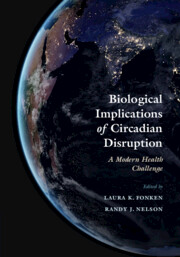Book contents
- Biological Implications of Circadian Disruption
- Biological Implications of Circadian Disruption
- Copyright page
- Contents
- Contributors
- Preface
- 1 Introduction to Circadian Rhythms
- 2 Central Clock Dynamics
- 3 Melatonin, Light, and the Circadian System
- 4 Disrupted Circadian Rhythms, Stress, and Allostatic Load
- 5 Disrupted Circadian Rhythms and Mental Health
- 6 Circadian Rhythms and Cognitive Functioning
- 7 Circadian Rhythm Disruption in Aging and Alzheimer’s Disease
- 8 Circadian Rhythms Regulate Neuroinflammation after Traumatic Brain Injury and Spinal Cord Injury
- 9 Disrupted Circadian Rhythms and Neuroendocrine Function in Fertility
- 10 Disrupted Circadian Rhythms and Metabolic Function
- 11 Disrupted Circadian Rhythms, Time Restricted Feeding, and Blood Pressure Regulation
- 12 Disrupted Circadian Rhythms and Immune Function
- 13 Circadian Rhythms and Cardiac Function
- 14 Disrupted Circadian Rhythms and Cancer
- 15 Light Effects across Species in Nature
- 16 Measurement and Analysis of Exposure to Light at Night in Epidemiology
- Index
- References
3 - Melatonin, Light, and the Circadian System
Published online by Cambridge University Press: 07 October 2023
- Biological Implications of Circadian Disruption
- Biological Implications of Circadian Disruption
- Copyright page
- Contents
- Contributors
- Preface
- 1 Introduction to Circadian Rhythms
- 2 Central Clock Dynamics
- 3 Melatonin, Light, and the Circadian System
- 4 Disrupted Circadian Rhythms, Stress, and Allostatic Load
- 5 Disrupted Circadian Rhythms and Mental Health
- 6 Circadian Rhythms and Cognitive Functioning
- 7 Circadian Rhythm Disruption in Aging and Alzheimer’s Disease
- 8 Circadian Rhythms Regulate Neuroinflammation after Traumatic Brain Injury and Spinal Cord Injury
- 9 Disrupted Circadian Rhythms and Neuroendocrine Function in Fertility
- 10 Disrupted Circadian Rhythms and Metabolic Function
- 11 Disrupted Circadian Rhythms, Time Restricted Feeding, and Blood Pressure Regulation
- 12 Disrupted Circadian Rhythms and Immune Function
- 13 Circadian Rhythms and Cardiac Function
- 14 Disrupted Circadian Rhythms and Cancer
- 15 Light Effects across Species in Nature
- 16 Measurement and Analysis of Exposure to Light at Night in Epidemiology
- Index
- References
Summary
This review summarizes evidence on the modulation of functional responses mediated by activation of the MT1 and/or MT2 melatonin receptors by endogenous or exogenous melatonin. Selective MT1 inverse agonists, discovered by docking ultra large compound libraries to the MT1 crystal structure, decelerated the rate of re-entrainment of activity rhythms to a new dark onset. Surprisingly, these inverse agonists advanced circadian phase when given at subjective dusk mimicking melatonin through actions at MT1 receptors. The efficacy of environmental carbamates with structural similarity to melatonin interact with melatonin receptors and in turn advance circadian clock phase, as with melatonin. In summary, melatonin receptors are targets for drugs modulating circadian rhythms to yield therapeutic effects (i.e., synchronization), as well as for environmental chemicals that may induce harmful effects on human health due to actions on melatonin and on/off target receptors (e.g., serotonin) involved in signaling circadian time at inappropriate times of day.
- Type
- Chapter
- Information
- Biological Implications of Circadian DisruptionA Modern Health Challenge, pp. 58 - 83Publisher: Cambridge University PressPrint publication year: 2023

